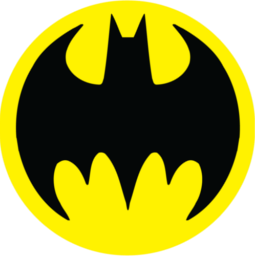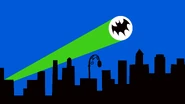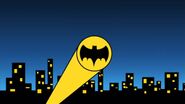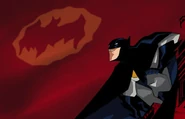(Adding categories) Tag: categoryselect |
No edit summary |
||
| (33 intermediate revisions by 11 users not shown) | |||
| Line 1: | Line 1: | ||
{{Infobox Object |
{{Infobox Object |
||
| − | |image=[[File:1565809-batsignal2.jpg| |
+ | |image=[[File:1565809-batsignal2.jpg|250px]] |
|Object name=Batsignal |
|Object name=Batsignal |
||
|official=Bat-Signal |
|official=Bat-Signal |
||
|appearance= [[Detective Comics Issue 60|''Detective Comics'' #60]] |
|appearance= [[Detective Comics Issue 60|''Detective Comics'' #60]] |
||
| + | |creator=[[Jack Schiff]] (writer)<br>[[George Roussos]] (artist)<br>[[Jerry Robinson]] (artist) |
||
|type=Modified Klieg Searchlight |
|type=Modified Klieg Searchlight |
||
|user=[[Gotham City Police Department]] |
|user=[[Gotham City Police Department]] |
||
| + | }} |
||
| − | + | {{quote|The signal goes on and he shows up. That's the way it's been, that's the way it will be.|[[James Gordon]]|Batman: Hush Money}} |
|
| + | |||
The '''Batsignal''' (or '''Bat-Signal''') is a distress signal device appearing in the various interpretations of the [[Batman]] mythos. It is a specially modified Klieg searchlight with a stylized symbol of a bat attached to the light so that it projects a large Bat emblem on the sky or buildings of [[Gotham City]]. |
The '''Batsignal''' (or '''Bat-Signal''') is a distress signal device appearing in the various interpretations of the [[Batman]] mythos. It is a specially modified Klieg searchlight with a stylized symbol of a bat attached to the light so that it projects a large Bat emblem on the sky or buildings of [[Gotham City]]. |
||
| Line 13: | Line 16: | ||
==History== |
==History== |
||
===Origins=== |
===Origins=== |
||
| − | The fictional origin of the signal varies between timeline and media. It made its first appearance in ''Detective Comics #60'', February 1942. |
+ | The fictional origin of the signal varies between timeline and media. It made its first appearance in ''Detective Comics #60'', February 1942. |
| − | In the comic's post-Crisis continuity, the signal was introduced after the Batman's first encounter against [[the Joker]] (not unlike the first movie) in ''Batman: The Man Who Laughs''; in Batman and the [[Mad Monk]], Gordon initially used a pager, but during a meeting with Batman he threw it away, saying that he couldn't sneak around in the shadows like Batman and wanted a more above-board means of contacting him. |
+ | In the comic's post-Crisis continuity, the signal was introduced after the Batman's first encounter against [[the Joker]] (not unlike the first movie) in ''Batman: The Man Who Laughs''; in Batman and the [[Mad Monk]], Gordon initially used a pager, but during a meeting with Batman he threw it away, saying that he couldn't sneak around in the shadows like Batman and wanted a more above-board means of contacting him. |
| − | |||
| − | in ''Batman: The Animated Series'', it was introduced in the episode "The Cape and Cowl Conspiracy". In ''The Batman'', Gordon invented it to summon Batman in "Night in the City" (it was somewhat similar to the 2005 film). |
||
==Used by Others== |
==Used by Others== |
||
| − | [[File:Batsignal-schumacher_films.jpg|thumb|left|270px|The Bat-Signal as seen in ''[[Batman Forever]]'' and ''[[Batman & Robin]]''.]] |
||
Others have used the Bat-Signal for their own purposes. |
Others have used the Bat-Signal for their own purposes. |
||
| Line 29: | Line 29: | ||
In ''Legends of the Dark Knight'' #6, a cadre of crime bosses projects the signal upside down in order to summon Batman to help them fight a killer they can't defeat. In the Halloween special comic series, ''Haunted Knight'', [[Scarecrow]] alters the Bat-Signal to notify Batman that he has kidnapped then-Captain Jim Gordon. By adding an orange bulb and painting "eyes" on the signal, he turns the beam into a stylized Jack-o'-lantern image (with the bat symbol forming the mouth beneath two eyes). |
In ''Legends of the Dark Knight'' #6, a cadre of crime bosses projects the signal upside down in order to summon Batman to help them fight a killer they can't defeat. In the Halloween special comic series, ''Haunted Knight'', [[Scarecrow]] alters the Bat-Signal to notify Batman that he has kidnapped then-Captain Jim Gordon. By adding an orange bulb and painting "eyes" on the signal, he turns the beam into a stylized Jack-o'-lantern image (with the bat symbol forming the mouth beneath two eyes). |
||
| − | [[File:Gordon O'Hara Bullock Bat-Signal1.jpg|thumb| |
+ | [[File:Gordon O'Hara Bullock Bat-Signal1.jpg|thumb|200px|The Bat-Signal as depicted in ''Batman'' #700. From left to right: [[Harvey Bullock]], [[James Gordon]], and [[Clancy O'Hara]].]]In ''[[Batman: Dark Victory]]'', [[Hangman]] sneaks onto the roof of Police Headquarters and turns the Bat-Signal on to lure then-recently appointed Commissioner James Gordon to the roof and try to kill him, but is thwarted when [[Two-Face]] cuts Gordon down. |
Near the beginning of the ''[[Batman: No Man's Land]]'' story arc, a junior officer creates an improvised Bat-Signal out of spare parts. Gordon smashes it to pieces as he is angry that Batman hasn't shown up. Oracle also builds a small Bat-Signal to summon Batman to talk to her after having seen [[Huntress]] wearing a Batgirl costume. |
Near the beginning of the ''[[Batman: No Man's Land]]'' story arc, a junior officer creates an improvised Bat-Signal out of spare parts. Gordon smashes it to pieces as he is angry that Batman hasn't shown up. Oracle also builds a small Bat-Signal to summon Batman to talk to her after having seen [[Huntress]] wearing a Batgirl costume. |
||
| Line 35: | Line 35: | ||
In the comic book series ''Gotham Central'', the purpose of the Bat-Signal is further expanded upon; as Batman's existence is not officially recognized by the Gotham City authorities, the Bat-Signal is explained as a method of using the "urban legend" around Batman to terrify Gotham's criminal underworld. |
In the comic book series ''Gotham Central'', the purpose of the Bat-Signal is further expanded upon; as Batman's existence is not officially recognized by the Gotham City authorities, the Bat-Signal is explained as a method of using the "urban legend" around Batman to terrify Gotham's criminal underworld. |
||
| − | + | As official proven police interaction with the Bat-Signal and Batman himself can lead to cases against criminals arrested by Batman being dismissed, it is up to the civilian employees of the Gotham police department (including the Major Case Squad's civilian attache, Stacy) to operate the signal officially. Owing to the events in the "War Crimes" storyline, relations between Batman and the [[Gotham City Police Department]] under Commissioner Michael Akins are officially severed; the Bat-Signal is removed from the roof of Gotham Central. Needing Batman's help on an extraordinary case, Akins brings out a spare bat signal for a single use. |
|
This signal is a more sophisticated laser which paints a green bat symbol in the clouds and is apparently more visible. This version of the signal is donated by Kord Industries (see the [[Blue Beetle]]). The laser signal is said to have been unused because the city council deems it an "inappropriate gift." (The characters are notably unimpressed by the more high tech version.) |
This signal is a more sophisticated laser which paints a green bat symbol in the clouds and is apparently more visible. This version of the signal is donated by Kord Industries (see the [[Blue Beetle]]). The laser signal is said to have been unused because the city council deems it an "inappropriate gift." (The characters are notably unimpressed by the more high tech version.) |
||
| Line 42: | Line 42: | ||
==In Other Media== |
==In Other Media== |
||
| + | ===Columbia serials=== |
||
| + | [[file:OG Batsignal.jpg|thumb|250px|Commissioner Gordon readies his batsignal projector ]] |
||
| + | In the 1943 serial, Batsignals are projected in the "Bat's Cave" and by [[Batman (Columbia serials)|Batman]] using a flashlight. [[Police Captain Arnold]] does not use it to contact him. |
||
| + | In the 1949 serial, Commissioner Gordon uses a modest sized Batsignal projector through the window of his office. |
||
| ⚫ | |||
| ⚫ | |||
| − | ==== |
+ | ====[[Batman (1960s series)|''Batman'' (1960s series)]]==== |
| − | [[File:Batman66-batsignal.jpg|thumb|341x341px|The 1960's Batsignal of the TV Series.]]Like in the comic books, it was used at night to call on [[Batman (Adam West)|Batman]] for help. |
||
| + | [[File:Batman66-batsignal.jpg|thumb|250px|A rare instance of the signal being lit in the [[William Dozier|Dozier]] series.]] |
||
| ⚫ | |||
| − | In the [[Batman |
+ | In the [[Batman: The Movie|1966 movie]], [[Robin (Dozierverse)|Robin]] asked [[Gordon (Dozierverse)|Commissioner Gordon]] to get Chief O'Hara to activate it as a distraction so that the criminals would think that they were headed for Police Headquarters. |
| − | |||
| ⚫ | |||
The Bat symbol in the sky was also used in the end credits of every episode and was seen on the access menu of the special edition DVD release of the film. |
The Bat symbol in the sky was also used in the end credits of every episode and was seen on the access menu of the special edition DVD release of the film. |
||
| + | <gallery> |
||
| − | ===Live-Action Films=== |
||
| + | Batman 1960s batsignal in end credits.jpg|The Batsignal seen in the end credits |
||
| ⚫ | |||
| − | + | Batsignal 1960s in movie dvd menu.jpg|The Batsignal seen in the movie DVD menu |
|
| + | </gallery> |
||
| ⚫ | |||
| ⚫ | |||
| ⚫ | |||
| + | [[File:BatmanTAS-batsignal.jpg|thumb|right|250px|The Batsignal in ''The New Batman Adventures'']] |
||
| ⚫ | |||
| + | In ''[[Batman: The Animated Series]]'', the Batsignal first appears in "[[Joker's Favor]]", where [[Charlie Collins]] improvises it to get [[Batman (DC Animated Universe)|Batman's]] attention. The Signal itself first appears in "[[The Cape and Cowl Conspiracy]]", with it being used by [[James Gordon (DC Animated Universe)|Gordon]] and the GCPD throughout the series. [[Barbara Gordon (DC Animated Universe)|Barbara Gordon]] also used the Bat-Signal to contact Batman in "[[Heart of Steel Part II]]", with it later being destroyed during a fight between them and a [[HARDAC]] duplicate of [[Harvey Bullock (DC Animated Universe)|Harvey Bullock]]. Likewise, the real Harvey Bullock used the Batsignal for the first time when he reluctantly asked for Batman's help in discovering who tried to kill him in "[[A Bullet for Bullock]]". |
||
| + | |||
| + | In the film ''[[Batman: Mask of the Phantasm]]'', [[Arthur Reeves]] and the GCPD, believing Batman had murdered several gang lords, attempt to use the Batsignal to lure him into a trap. However, he knew of the ploy and did not respond. |
||
| + | |||
| + | In ''[[Batman Beyond]]'', [[Paxton Power]] uses the Batsignal to summon [[Terry McGinnis (DC Animated Universe)|Terry McGinnis]] to help locate [[Blight|his father]] in "[[Ascension]]". Upon arriving, Batman destroyed the Batsignal, suggesting he used "email". |
||
| + | |||
| + | ===Film=== |
||
| ⚫ | |||
| + | [[file:1989 WB Batsignal.png|thumb|250px|The Batsignal as seen at the end of ''Batman''.]] |
||
| ⚫ | |||
| + | |||
| ⚫ | In [[Batman (1989 film)|''Batman'']], [[Batman (Burtonverse)|Batman]] gave the Batsignal to the [[Gotham City Police Department (Burtonverse)|GCPD]] after the death of the [[The Joker (Jack Nicholson)|Joker]] as a gift so that when he was needed, they could summon him. Originally the Batsignal was going to be projected onto the side of [[Gotham Cathedral (Burton Films)|a building]] like the more realistic version seen in the [[Batman: The Dark Knight|1986 ''Dark Knight'' series]]. When the ending was reshot, a more traditional use of the signal into the sky was used. |
||
| + | |||
| + | [[file:Bruce Wayne Batsignal.jpg|thumb|250px|A unique alert system is shown at the beginning of ''Batman Returns'', reflecting the signal directly in Wayne's private study.]] |
||
| + | {{quote|What are you waiting for? The Signal!|[[James Gordon (Pat Hingle)|Commissioner Gordon]]|Batman Returns}} |
||
| ⚫ | In ''[[Batman Returns]]'', Bruce had automated mirrors stationed up around the top of [[Wayne Manor (Burtonverse)|Wayne Manor]] that would reflect the signal directly through the window of his study. It was seen when [[James Gordon (Pat Hingle)|Commissioner Gordon]] needed his help when the [[Red Triangle Gang]] attacked [[Gotham Plaza]] during the the initial [[Lighting of the Tree Ceremony]]. |
||
| + | Much like the first film, the ending with the Batsignal was changed at the last minute. Originally the film was to end with the city's lights flickering off and on, with Gordon and the [[Roscoe Jenkins|Mayor]] desperately lighting the faulty signal. Instead, [[Catwoman (Michelle Pfeiffer)|Catwoman]] is shown looking up at the signal, similar to the ending of the first film. |
||
| ⚫ | In ''[[Batman Returns]]'', Bruce had |
||
| + | [[File:UjTNmCphCg0.jpg|thumb|250px|Batsignal above Gotham skyline]] |
||
| − | ====Schumacher Films==== |
||
| − | {{ |
+ | {{Quote|You called me here for this? The Bat-Signal is not a beeper.|Batman to Chase Meridian|Batman Forever}} |
| − | [[File:Riddler_Batsignal.png|thumb| |
+ | [[File:Riddler_Batsignal.png|thumb|250px|The Riddler's altered Batsignal.]] |
| − | In ''[[Batman Forever]]'', the criminal psychologist Dr. [[Chase Meridian]] used the Batsignal to call |
+ | In ''[[Batman Forever]]'', the criminal psychologist Dr. [[Chase Meridian]] used the Batsignal to call Batman in order to seduce him. Batman was slightly peeved at her usage of the Batsignal as a mere "beeper". Later in the film, the [[The Riddler (Jim Carrey)|Riddler]] altered the Batsignal by projecting a question mark into the sky with the original bat symbol forming the dot at the base. The signal was later restored when Batman flew the Batwing right through the signal much to Commissioner Gordon's delight. At the end of the film, Batman and Robin were shown in silhouette running in front of the Bat-Signal. |
| + | The music video for ''Kiss from a Rose'', also from the film and was directed by Schumacher, featured singer Seal performing the song while he stood beside the Batsignal. |
||
| − | Also in ''Batman Forever'', [[The Riddler (Jim Carrey)|The Riddler]] altered the Batsignal by projecting a question mark into the sky with the original bat symbol forming the dot at the base. Similarly, in ''[[Batman: Dark Victory]]'', after he brokered a tentative alliance with Batman, the Riddler changed the signal, and projected a question mark into the sky in order to let Batman know that he had an answer for him. |
||
| − | [[Image:Gotham City Batman & Robin.jpg|thumb| |
+ | [[Image:Gotham City Batman & Robin.jpg|thumb|250px|The Robinsignal that was made by Poison Ivy.]] |
In ''[[Batman & Robin]]'', [[Poison Ivy (Uma Thurman)|Poison Ivy]] acquired the location and keys to the Batsignal after she seduced Commissioner Gordon who revealed information about it. Ivy and [[Bane (Jeep Swenson)|Bane]] removed the Batsignal from the top of GCPD Headquarters and took it back to her lair. |
In ''[[Batman & Robin]]'', [[Poison Ivy (Uma Thurman)|Poison Ivy]] acquired the location and keys to the Batsignal after she seduced Commissioner Gordon who revealed information about it. Ivy and [[Bane (Jeep Swenson)|Bane]] removed the Batsignal from the top of GCPD Headquarters and took it back to her lair. |
||
| − | Ivy then altered the Batsignal by changing the Bat-symbol to a Robin-symbol in order to lure [[Robin (Chris O'Donnell)|Robin]] into a trap. However, Robin was able to trick Ivy into revealing [[Mr. Freeze (Arnold Schwarzenegger)|Mr. Freeze]]'s plan to freeze [[Gotham City ( |
+ | Ivy then altered the Batsignal by changing the Bat-symbol to a Robin-symbol in order to lure [[Robin (Chris O'Donnell)|Robin]] into a trap. However, Robin was able to trick Ivy into revealing [[Mr. Freeze (Arnold Schwarzenegger)|Mr. Freeze]]'s plan to freeze [[Gotham City (Burtonverse)|Gotham City]]. At the end of the film, the Batsignal was later restored when Batman, Robin and [[Batgirl (Alicia Silverstone)|Batgirl]] were running in front of it before the credits. |
| − | ==== |
+ | ====The Dark Knight Trilogy==== |
| − | [[File:Nolan_batsiganl-batmanbegins.jpg|thumb| |
+ | [[File:Nolan_batsiganl-batmanbegins.jpg|thumb|250px|The Nolanverse Batsignal.]][[File:Nolan_Batsignal-high-resolution-snapshot.jpeg|thumb|250px|The Batsignal in ''The Dark Knight'', moments before it was taken down by Commissioner Gordon.]] |
In ''[[Batman Begins]]'', [[Batman (Christian Bale)|Batman]] initially 'improvised' a Batsignal by draping crime boss [[Carmine Falcone (Tom Wilkinson)|Carmine Falcone]] over a spotlight at the docks after he defeated him, and his spread-out trench coat made the light look like a bat. At the conclusion of the film, Lieutenant [[James Gordon (Gary Oldman)|James Gordon]] created the actual Batsignal to call Batman to the roof for a talk, although he jokingly commented that he only used it because they couldn't find any mob bosses to strap to it. |
In ''[[Batman Begins]]'', [[Batman (Christian Bale)|Batman]] initially 'improvised' a Batsignal by draping crime boss [[Carmine Falcone (Tom Wilkinson)|Carmine Falcone]] over a spotlight at the docks after he defeated him, and his spread-out trench coat made the light look like a bat. At the conclusion of the film, Lieutenant [[James Gordon (Gary Oldman)|James Gordon]] created the actual Batsignal to call Batman to the roof for a talk, although he jokingly commented that he only used it because they couldn't find any mob bosses to strap to it. |
||
| − | In ''[[The Dark Knight]]'', Gordon used the Batsignal to remind Gotham of Batman's presence. The Batsignal proved to be very effective, with drug dealers and criminals who became apprehensive at its appearance. However, since the [[Gotham City Police Department ( |
+ | In ''[[The Dark Knight]]'', Gordon used the Batsignal to remind Gotham of Batman's presence. The Batsignal proved to be very effective, with drug dealers and criminals who became apprehensive at its appearance. However, since the [[Gotham City Police Department (Nolanverse)|GCPD]] were supposed to be tracking Batman, they chalked it up to "light problems" when it was used. At the end of the film, after he agreed to blame Batman for the murders that were committed by [[Two-Face (Aaron Eckhart)|Harvey Dent]] in order to preserve the latter's image as Gotham's hero, Gordon destroyed the Batsignal in front of various members of the GCPD and the Gotham press. |
| + | [[File:Batsignal.jpg|thumb|250px|Rebuilt Batsignal in ''The Dark Knight Rises''.]] |
||
| − | |||
In ''[[The Dark Knight Rises]]'', at the beginning, Gordon was seen contemplating Harvey Dent over the heavily rusted remains of the searchlight. At the end, a new rebuilt Batsignal was installed in its place, which surprised Gordon, though it honored Batman, but had no use, as Batman was presumed dead. |
In ''[[The Dark Knight Rises]]'', at the beginning, Gordon was seen contemplating Harvey Dent over the heavily rusted remains of the searchlight. At the end, a new rebuilt Batsignal was installed in its place, which surprised Gordon, though it honored Batman, but had no use, as Batman was presumed dead. |
||
| − | === |
+ | ====The LEGO Movies==== |
| + | In ''[[wikipedia:The Lego Movie|The LEGO Movie]]'', a Batsignal is created when [[Batman (Lego Movie)|Batman]] crashes the Batwing into the sun. The signal itself appears in ''[[The Lego Batman Movie|The LEGO Batman Movie]]'', where it is "egged" by [[Egghead]] to stop the GCPD from calling him. During the climax, Batman commissions multiple signals for his allies and enemies, rallying them to fight [[The Joker (Lego Movie)|Joker]] and the [[Phantom Zone Criminals (The Lego Batman Movie)|Phantom Zone escapees]]. |
||
| ⚫ | |||
| ⚫ | |||
| − | In ''[[Batman: The Animated Series]]'', [[Barbara Gordon (DC Animated Universe)|Barbara Gordon]] used it to contact [[Batman (DC Animated Universe)|Batman]] in "[[Heart of Steel Part II]]" when she believed that an impostor had replaced her father. At that meeting, the Batsignal was partially destroyed when Batman was attacked by a [[Harvey Bullock (DC Animated Universe)|Harvey Bullock]] duplicate, and Barbara usesd Batman's Grapple Gun to pull the robot into the signal, and electrocuted it. Likewise, the real Harvey Bullock used the Batsignal for the first time when he reluctantly asked for Batman's help in discovering who tried to kill him in "[[A Bullet for Bullock]]". |
||
| + | ====DC Extend Universe==== |
||
| − | [[File:BatmanTAS-batsignal.jpg|thumb|left|186px|The Batsignal in ''Batman: The Animated Series''.]]In the film that was based on the aforementioned series, ''[[Batman: Mask of the Phantasm]]'', Batman was hunted by GCPD on suspicions that he had murdered several gang lords, and Bullock, under orders from Councilman [[Arthur Reeves]], tried to use the Batsignal to lure him in. Batman, after he knew that it was a trap, did not respond. |
||
| + | In ''[[Batman v Superman: Dawn of Justice]]'', [[Batman (Ben Affleck)|Batman]] uses the Batsignal to summon [[Superman (Henry Cavill)|Superman]] to fight him. It is also destroyed during the fight. The Signal itself can be seen from [[Metropolis]]. |
||
| + | In ''[[Justice League (film)|Justice League]]'', [[James Gordon (J. K. Simmons)|Gordon]] uses it to summon Batman and [[Justice League (DC Extended Universe)|his allies]], to ask them to investigate the kidnapping of [[S.T.A.R. Labs]] employees. It can also be seen during the film's closing moments. |
||
| − | In ''[[Batman Beyond]]'', [[Terry McGinnis (DC Animated Universe)|Terry McGinnis]] destroyed the Batsignal after it was used for the first time in years by Paxton Powers, the son of [[Blight|Derek Powers]], who used the signal to contact Batman with the intention of using him to locate and deal with his father. |
||
===Video Games=== |
===Video Games=== |
||
| − | ===='' |
+ | ====''Batman: Arkham'' Series==== |
| + | [[File:BatmanArkhamAsylum-batsignal.jpg|thumb|250px|The Batsignal in ''Arkham City''.]] |
||
| − | In ''Batman: Arkham Asylum'', the Batsignal was first seen in the sky while [[Batman (Arkhamverse)|Batman]] drove the [[Batmobile (Arkhamverse)|Batmobile]] through Gotham to deliver [[The Joker (Arkhamverse)| |
+ | In ''Batman: Arkham Asylum'', the Batsignal was first seen in the sky while [[Batman (Arkhamverse)|Batman]] drove the [[Batmobile (Arkhamverse)|Batmobile]] through Gotham to deliver [[The Joker (Arkhamverse)|Joker]] to [[Arkham Island]]. To escape [[Scarecrow (Arkhamverse)|Scarecrow]] 's-induced nightmares, Batman sneaked through the remains of Arkham and defeated a gigantic Scarecrow by aiming the Batsignal at him. During the second encounter with Scarecrow, Batman relived the death of his parents, where he knelt down to his parents as an 8 year old Bruce and a Batsignal shined on him. |
| + | [[File:BatmanArkhamKnightGothamCity2.jpg|thumb|250px|The Batsignal in ''Arkham Knight''.]] |
||
| ⚫ | |||
| + | |||
| ⚫ | |||
| + | |||
| ⚫ | |||
| + | [[File:Batsignal Telltale.jpg|thumb|250px|Batsignal in ''Batman: The Telltale Series''.]] |
||
| + | In ''[[Batman: The Telltale Series]]'', the Batsignal first appears during the opening minutes of "[[New World Order]]", where it is used by [[James Gordon (Telltale)|Lt Gordon]] to call for Batman. If [[The Penguin (Telltale)|Penguin]] is defeated during "[[Guardian of Gotham]]", Gordon uses it again during opening for "[[City of Light]]", summoning Batmant to help defend them from [[Two-Face (Telltale)|Harvey Dent's]] enforcers. |
||
| + | In ''[[Batman: The Enemy Within]]'', the Batsignal is used multiple times to summon Batman to Gotham City Police Headquarters. During "[[The Pact (episode)|The Pact]]", [[Amanda Waller (Telltale)|Amanda Waller]] criticizes Gordon for using it, arguing it is not a logistical method of getting his attention. During the Vigilante Joker route of "[[Same Stitch]]", the signal is thrown by [[Bane (Telltale)|Bane]] during the fight between Batman, [[The Joker (Telltale)|Joker]] and the [[Suicide Squad|"special taskforce"]]. The signal can also be seen at the end of the episode, where Bruce must chose whether to respond to it or not to convince [[Alfred Pennyworth (Telltale)|Alfred]] to stay. |
||
| ⚫ | |||
| ⚫ | |||
| + | ==Gallery== |
||
| − | ====''[[Batman: Arkham Knight]]''==== |
||
| + | <gallery> |
||
| ⚫ | |||
| + | Thebatman2004_signal_2.jpg|The signal in ''[[The Batman]]'' |
||
| + | </gallery> |
||
| + | ==External links== |
||
| + | * [[w:c:dc:Bat-Signal|Bat-Signal]] at [[w:c:dc:Main_Page|DC Comics Database]] |
||
[[Category:Objects]] |
[[Category:Objects]] |
||
| − | [[Category:Batman: The Animated Series Objects]] |
||
| − | [[Category:Batman (1989 Movie) Objects]] |
||
| − | [[Category:Batman Returns Objects]] |
||
| − | [[Category:Batman Forever Objects]] |
||
| − | [[Category:Batman & Robin Objects]] |
||
| − | [[Category:Batman Begins Objects]] |
||
| − | [[Category:The Dark Knight Objects]] |
||
| − | [[Category:The Dark Knight Rises Objects]] |
||
| − | [[Category:Batman v Superman: Dawn of Justice Objects]] |
||
| − | [[Category:Batman (1966 Movie)]] |
||
| − | [[Category:Batman (1960s series)]] |
||
| − | [[Category:Batman (1989 Movie)]] |
||
| − | [[Category:Batman Returns]] |
||
| − | [[Category:Batman Forever]] |
||
| − | [[Category:Batman & Robin]] |
||
| − | [[Category:Batman Begins]] |
||
| − | [[Category:The Dark Knight Rises]] |
||
| − | [[Category:Batman: The Animated Series]] |
||
| − | [[Category:Batman Beyond]] |
||
Revision as of 20:59, 20 May 2020
- "The signal goes on and he shows up. That's the way it's been, that's the way it will be."
- ―James Gordon[src]
The Batsignal (or Bat-Signal) is a distress signal device appearing in the various interpretations of the Batman mythos. It is a specially modified Klieg searchlight with a stylized symbol of a bat attached to the light so that it projects a large Bat emblem on the sky or buildings of Gotham City.
In the stories, the signal is used by the Gotham City Police Department as a method of contacting and summoning Batman to their assistance in the event of a serious crisis and as a weapon of psychological intimidation to the numerous villains of Gotham City.
History
Origins
The fictional origin of the signal varies between timeline and media. It made its first appearance in Detective Comics #60, February 1942.
In the comic's post-Crisis continuity, the signal was introduced after the Batman's first encounter against the Joker (not unlike the first movie) in Batman: The Man Who Laughs; in Batman and the Mad Monk, Gordon initially used a pager, but during a meeting with Batman he threw it away, saying that he couldn't sneak around in the shadows like Batman and wanted a more above-board means of contacting him.
Used by Others
Others have used the Bat-Signal for their own purposes.
In the "Lovers and Madmen" story arc from Batman Confidential, which retells the origin of the Joker and his first encounter with Batman, Batman sees the Bat-Signal for the first time and assumes that Gordon created it to ask for his help in battling the Joker. When he reaches the rooftop, however, he finds that the Joker actually created it, and used it to force a confrontation with Batman.
In Detective Comics #466 (1976), the villainous Signalman manages to trap the Batman inside the Bat-Signal device.
In Legends of the Dark Knight #6, a cadre of crime bosses projects the signal upside down in order to summon Batman to help them fight a killer they can't defeat. In the Halloween special comic series, Haunted Knight, Scarecrow alters the Bat-Signal to notify Batman that he has kidnapped then-Captain Jim Gordon. By adding an orange bulb and painting "eyes" on the signal, he turns the beam into a stylized Jack-o'-lantern image (with the bat symbol forming the mouth beneath two eyes).
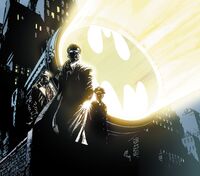
The Bat-Signal as depicted in Batman #700. From left to right: Harvey Bullock, James Gordon, and Clancy O'Hara.
In Batman: Dark Victory, Hangman sneaks onto the roof of Police Headquarters and turns the Bat-Signal on to lure then-recently appointed Commissioner James Gordon to the roof and try to kill him, but is thwarted when Two-Face cuts Gordon down.
Near the beginning of the Batman: No Man's Land story arc, a junior officer creates an improvised Bat-Signal out of spare parts. Gordon smashes it to pieces as he is angry that Batman hasn't shown up. Oracle also builds a small Bat-Signal to summon Batman to talk to her after having seen Huntress wearing a Batgirl costume.
In the comic book series Gotham Central, the purpose of the Bat-Signal is further expanded upon; as Batman's existence is not officially recognized by the Gotham City authorities, the Bat-Signal is explained as a method of using the "urban legend" around Batman to terrify Gotham's criminal underworld.
As official proven police interaction with the Bat-Signal and Batman himself can lead to cases against criminals arrested by Batman being dismissed, it is up to the civilian employees of the Gotham police department (including the Major Case Squad's civilian attache, Stacy) to operate the signal officially. Owing to the events in the "War Crimes" storyline, relations between Batman and the Gotham City Police Department under Commissioner Michael Akins are officially severed; the Bat-Signal is removed from the roof of Gotham Central. Needing Batman's help on an extraordinary case, Akins brings out a spare bat signal for a single use.
This signal is a more sophisticated laser which paints a green bat symbol in the clouds and is apparently more visible. This version of the signal is donated by Kord Industries (see the Blue Beetle). The laser signal is said to have been unused because the city council deems it an "inappropriate gift." (The characters are notably unimpressed by the more high tech version.)
In the 52 series, The Question alters the traditional Bat-Signal to project a spray-painted question mark. In the One Year Later series, however, with the re-installation of James Gordon as commissioner, relations with Batman appear to have thawed; upon Batman's return from one year of self-imposed exile, the Bat-Signal (restored to the roof of police headquarters) is activated once again. The familiar sight of the Bat symbol in the sky prompts cheers from most of the citizens of Gotham.
In Other Media
Columbia serials
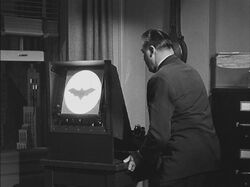
Commissioner Gordon readies his batsignal projector
In the 1943 serial, Batsignals are projected in the "Bat's Cave" and by Batman using a flashlight. Police Captain Arnold does not use it to contact him.
In the 1949 serial, Commissioner Gordon uses a modest sized Batsignal projector through the window of his office.
Television
Batman (1960s series)
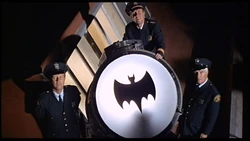
A rare instance of the signal being lit in the Dozier series.
The Batsignal was rarely used in the live-action television series because the Commissioner usually contacted Batman in the daytime with his Batphone, in a radical departure from the comics.
In the 1966 movie, Robin asked Commissioner Gordon to get Chief O'Hara to activate it as a distraction so that the criminals would think that they were headed for Police Headquarters.
The Bat symbol in the sky was also used in the end credits of every episode and was seen on the access menu of the special edition DVD release of the film.
DC Animated Universe
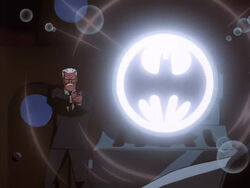
The Batsignal in The New Batman Adventures
- "You've a call on your private line."
- ―Alfred Pennyworth to Batman[src]
In Batman: The Animated Series, the Batsignal first appears in "Joker's Favor", where Charlie Collins improvises it to get Batman's attention. The Signal itself first appears in "The Cape and Cowl Conspiracy", with it being used by Gordon and the GCPD throughout the series. Barbara Gordon also used the Bat-Signal to contact Batman in "Heart of Steel Part II", with it later being destroyed during a fight between them and a HARDAC duplicate of Harvey Bullock. Likewise, the real Harvey Bullock used the Batsignal for the first time when he reluctantly asked for Batman's help in discovering who tried to kill him in "A Bullet for Bullock".
In the film Batman: Mask of the Phantasm, Arthur Reeves and the GCPD, believing Batman had murdered several gang lords, attempt to use the Batsignal to lure him into a trap. However, he knew of the ploy and did not respond.
In Batman Beyond, Paxton Power uses the Batsignal to summon Terry McGinnis to help locate his father in "Ascension". Upon arriving, Batman destroyed the Batsignal, suggesting he used "email".
Film
Burton/Schumacher Series
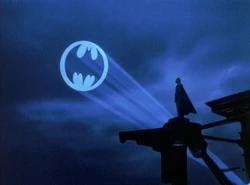
The Batsignal as seen at the end of Batman.
- "Please inform the citizens of Gotham that Gotham City has earned a rest from crime. But if the forces of evil should rise again, to cast a shadow on the heart of the city, call me."
- ―Batman's letter to the GCPD.[src]
In Batman, Batman gave the Batsignal to the GCPD after the death of the Joker as a gift so that when he was needed, they could summon him. Originally the Batsignal was going to be projected onto the side of a building like the more realistic version seen in the 1986 Dark Knight series. When the ending was reshot, a more traditional use of the signal into the sky was used.
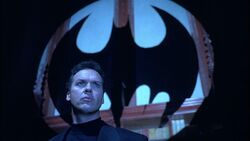
A unique alert system is shown at the beginning of Batman Returns, reflecting the signal directly in Wayne's private study.
- "What are you waiting for? The Signal!"
- ―Commissioner Gordon[src]
In Batman Returns, Bruce had automated mirrors stationed up around the top of Wayne Manor that would reflect the signal directly through the window of his study. It was seen when Commissioner Gordon needed his help when the Red Triangle Gang attacked Gotham Plaza during the the initial Lighting of the Tree Ceremony.
Much like the first film, the ending with the Batsignal was changed at the last minute. Originally the film was to end with the city's lights flickering off and on, with Gordon and the Mayor desperately lighting the faulty signal. Instead, Catwoman is shown looking up at the signal, similar to the ending of the first film.
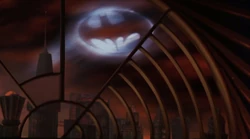
Batsignal above Gotham skyline
- "You called me here for this? The Bat-Signal is not a beeper."
- ―Batman to Chase Meridian[src]
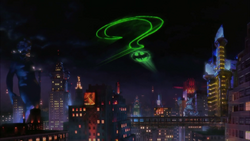
The Riddler's altered Batsignal.
In Batman Forever, the criminal psychologist Dr. Chase Meridian used the Batsignal to call Batman in order to seduce him. Batman was slightly peeved at her usage of the Batsignal as a mere "beeper". Later in the film, the Riddler altered the Batsignal by projecting a question mark into the sky with the original bat symbol forming the dot at the base. The signal was later restored when Batman flew the Batwing right through the signal much to Commissioner Gordon's delight. At the end of the film, Batman and Robin were shown in silhouette running in front of the Bat-Signal.
The music video for Kiss from a Rose, also from the film and was directed by Schumacher, featured singer Seal performing the song while he stood beside the Batsignal.

The Robinsignal that was made by Poison Ivy.
In Batman & Robin, Poison Ivy acquired the location and keys to the Batsignal after she seduced Commissioner Gordon who revealed information about it. Ivy and Bane removed the Batsignal from the top of GCPD Headquarters and took it back to her lair.
Ivy then altered the Batsignal by changing the Bat-symbol to a Robin-symbol in order to lure Robin into a trap. However, Robin was able to trick Ivy into revealing Mr. Freeze's plan to freeze Gotham City. At the end of the film, the Batsignal was later restored when Batman, Robin and Batgirl were running in front of it before the credits.
The Dark Knight Trilogy
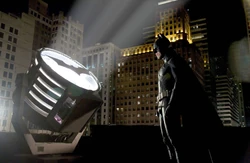
The Nolanverse Batsignal.
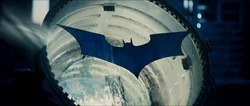
The Batsignal in The Dark Knight, moments before it was taken down by Commissioner Gordon.
In Batman Begins, Batman initially 'improvised' a Batsignal by draping crime boss Carmine Falcone over a spotlight at the docks after he defeated him, and his spread-out trench coat made the light look like a bat. At the conclusion of the film, Lieutenant James Gordon created the actual Batsignal to call Batman to the roof for a talk, although he jokingly commented that he only used it because they couldn't find any mob bosses to strap to it.
In The Dark Knight, Gordon used the Batsignal to remind Gotham of Batman's presence. The Batsignal proved to be very effective, with drug dealers and criminals who became apprehensive at its appearance. However, since the GCPD were supposed to be tracking Batman, they chalked it up to "light problems" when it was used. At the end of the film, after he agreed to blame Batman for the murders that were committed by Harvey Dent in order to preserve the latter's image as Gotham's hero, Gordon destroyed the Batsignal in front of various members of the GCPD and the Gotham press.
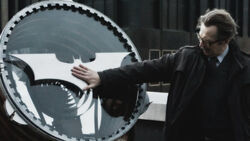
Rebuilt Batsignal in The Dark Knight Rises.
In The Dark Knight Rises, at the beginning, Gordon was seen contemplating Harvey Dent over the heavily rusted remains of the searchlight. At the end, a new rebuilt Batsignal was installed in its place, which surprised Gordon, though it honored Batman, but had no use, as Batman was presumed dead.
The LEGO Movies
In The LEGO Movie, a Batsignal is created when Batman crashes the Batwing into the sun. The signal itself appears in The LEGO Batman Movie, where it is "egged" by Egghead to stop the GCPD from calling him. During the climax, Batman commissions multiple signals for his allies and enemies, rallying them to fight Joker and the Phantom Zone escapees.
DC Extend Universe
In Batman v Superman: Dawn of Justice, Batman uses the Batsignal to summon Superman to fight him. It is also destroyed during the fight. The Signal itself can be seen from Metropolis.
In Justice League, Gordon uses it to summon Batman and his allies, to ask them to investigate the kidnapping of S.T.A.R. Labs employees. It can also be seen during the film's closing moments.
Video Games
Batman: Arkham Series
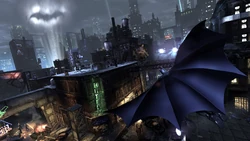
The Batsignal in Arkham City.
In Batman: Arkham Asylum, the Batsignal was first seen in the sky while Batman drove the Batmobile through Gotham to deliver Joker to Arkham Island. To escape Scarecrow 's-induced nightmares, Batman sneaked through the remains of Arkham and defeated a gigantic Scarecrow by aiming the Batsignal at him. During the second encounter with Scarecrow, Batman relived the death of his parents, where he knelt down to his parents as an 8 year old Bruce and a Batsignal shined on him.
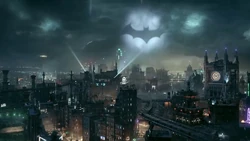
The Batsignal in Arkham Knight.
In Batman: Arkham City, the Batsignal was used as a waypoint in the sky, and hovered as an objective marker while Batman roamed Arkham City. The original Batsignal light was found on the roof of the old GCPD Building at Amusement Mile (as the subject of a Riddle).
In Batman: Arkham Knight, Commissioner Gordon used the Batsignal to contact Batman about the evacuation of Gotham's citizens and Scarecrow's plans.
Batman: The Telltale Series
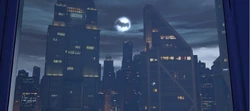
Batsignal in Batman: The Telltale Series.
In Batman: The Telltale Series, the Batsignal first appears during the opening minutes of "New World Order", where it is used by Lt Gordon to call for Batman. If Penguin is defeated during "Guardian of Gotham", Gordon uses it again during opening for "City of Light", summoning Batmant to help defend them from Harvey Dent's enforcers.
In Batman: The Enemy Within, the Batsignal is used multiple times to summon Batman to Gotham City Police Headquarters. During "The Pact", Amanda Waller criticizes Gordon for using it, arguing it is not a logistical method of getting his attention. During the Vigilante Joker route of "Same Stitch", the signal is thrown by Bane during the fight between Batman, Joker and the "special taskforce". The signal can also be seen at the end of the episode, where Bruce must chose whether to respond to it or not to convince Alfred to stay.
